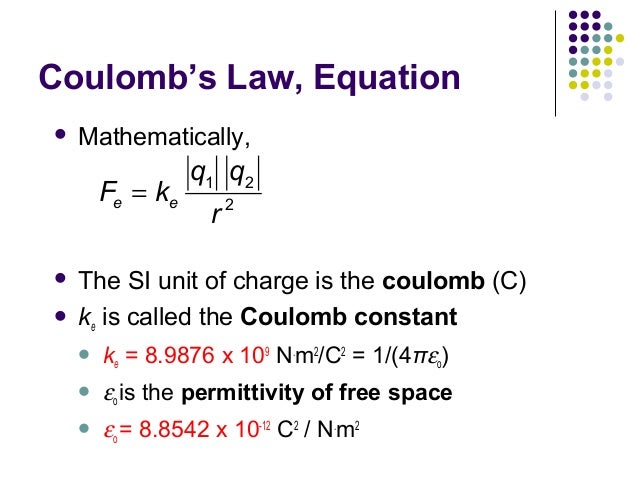Maxwell’s equations are the basic equations of electromagnetism which are a collection of Gauss’s law for electricity, Gauss’s law for magnetism, Faraday’s law of electromagnetic induction and Ampere’s law for currents in conductors. Maxwell equations give a mathematical model for electric, optical, and radio technologies, like power generation, electric motors, wireless communication, radar, and, Lenses, etc. These Equations explain how magnetic and electric fields are produced from charges.
These equations are part of the comprehensive and symmetrical theory of electromagnetism, which is essential to understand electromagnetic waves, optics, radio and TV transmission, microwave ovens and magnetically levitated trains.
- Maxwell's Two Equations For Electrostatic Fields Based
- Electrostatic Field Energy
- Maxwell's Two Equations For Electrostatic Fields Worksheet
- Maxwell's Two Equations For Electrostatic Fields Two
- Electrostatic Field Lines
What are the four Maxwell’s Equations?
Maxwell noted the presence of the velocity c in the structure of the electromagnetic field before such wave processes were realized experi-mentally. This velocity is basic to such relations as the famed E = mc2, and the Lorentz transformation. It appears as a more fundamental and more general attribute than the field equations themselves (Holm, 1960). Ari lennox pedigree. The introduction of the vector potential, →A, and the scalar potential, →V, enables one to satisfy the first two of Maxwell’s equations (7.2.1). Write →E and →B in terms of the potentials in the second pair of Maxwell’s equations to obtain curlcurl(→A) = μ0→JT + ϵ0μ0(− → grad∂V ∂t − ∂2→A ∂t2). 5-02-2007 Preparatory School on Fiber Optics, Fiber Lasers and Sensors 3 Introduction. In electrodynamics Maxwell’s equations are a set of four equations, that describes the behavior of both the electric and magnetic fields as well as.
The four of Maxwell’s equations for free space are:
The First Maxwell’s equation (Gauss’s law for electricity)
The Gauss’s law states that flux passing through any closed surface is equal to 1/ε0 times the total charge enclosed by that surface.
Integral form of Maxwell’s 1st equation
It is the integral form of Maxwell’s 1st equation.
Maxwell’s first equation in differential form
It is called the differential form of Maxwell’s 1st equation.
The Second Maxwell’s equation (Gauss’s law for magnetism)
The Gauss’s law for magnetism states that net flux of the magnetic field through a closed surface is zero because monopoles of a magnet do not exist.
The Third Maxwell’s equation (Faraday’s law of electromagnetic induction )
According to Faraday’s law of electromagnetic induction
It is the differential form of Maxwell’s third equation.
Visit Our Page for Related Topics: Electromagnetism
Suggested Video:
The Fourth Maxwell’s equation ( Ampere’s law)
The magnitude of the magnetic field at any point is directly proportional to the strength of the current and inversely proportional to the distance of the point from the straight conductors is called Ampere’s law.
Third Maxwell’s equation says that a changing magnetic field produces an electric field. But there is no clue in fourth Maxwell’s equation whether a changing electric field produces a magnetic field? To overcome this deficiency, Maxwell’s argued that if a changing magnetic flux can produce an electric field then by symmetry there must exist a relation in which a changing electric field must produce a changing magnetic flux.
For more related informative topics Visit our Page: Electricity and Magnetism
Related Topics:
Physics Related Links:
Graduate Aptitude Test in Engineering
GATE ECE
Network TheoryControl Systems
Electronic Devices and Vlsi
Analog Circuits
Digital Circuits
Microprocessors
Signals and Systems
Communications
Electromagnetics
General Aptitude
Engineering Mathematics
GATE CSE
Discrete MathematicsProgramming Languages
Theory of Computation
Operating Systems
Digital Logic
Computer Organization
Database Management System
Data Structures
Computer Networks
Algorithms
Compiler Design
Software Engineering
Web Technologies
General Aptitude
GATE CE
Engineering MechanicsStrength of Materials Or Solid Mechanics
Structural Analysis
Construction Material and Management
Reinforced Cement Concrete
Steel Structures
 Geotechnical Engineering
Geotechnical EngineeringFluid Mechanics and Hydraulic Machines
Hydrology
Irrigation
Environmental Engineering
Transportation Engineering
Geomatics Engineering Or Surveying

Engineering Mathematics
General Aptitude
GATE EE
Electric CircuitsElectromagnetic Fields
Signals and Systems
Maxwell's Two Equations For Electrostatic Fields Based
Electrical MachinesEngineering Mathematics
General Aptitude
Power System Analysis
Electrical and Electronics Measurement
Analog Electronics
Control Systems
Power Electronics
Digital Electronics
GATE ME
Engineering MechanicsStrength of Materials
Theory of Machines
Engineering Mathematics
Machine Design
Fluid Mechanics
Turbo Machinery
Heat Transfer
Thermodynamics
Production Engineering
Industrial Engineering
General Aptitude
GATE PI
Engineering MechanicsStrength of Materials
Electrostatic Field Energy
Theory of Machines
Engineering Mathematics
Machine Design
Fluid Mechanics
Maxwell's Two Equations For Electrostatic Fields Worksheet
Heat Transfer
Thermodynamics
Casting
Metal Forming
 Joining of Materials
Joining of MaterialsMachine Tools and Machining
Metrology